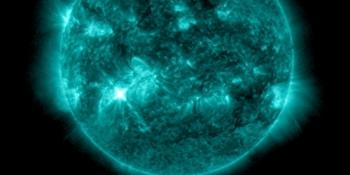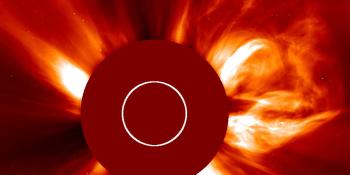Просмотр архива за среда, 18 июня 2003
Отчет о солнечной активности
Любая солнечная вспышка, упомянутая в этом расчете, имеет масштабирующий коэффициент, применяемый Центром прогнозирования космической погоды (SWPC). Из-за него солнечные вспышки здесь на 42% слабее, чем в научных данных. Из наших архивов этот коэффициент был удален, чтобы показать реальные величины вспышек.
Отчет о солнечно-геофизической активности 2003 Jun 18 2200 UTCПодготовлено NOAA © SWPC и представлено SpaceWeatherLive.com
Совместный отчет USAF/NOAA о солнечной и геофизической активности
Количество SD 169 на уровне 2200Z 18 Jun 2003IA. Анализ активных солнечных регионов и активности от 17 - 2100Z до 18 - 2100Z Solar activity increased to high levels today. Region
386 (S07E43) produced an M6.8 x-ray flare (correlated using SXI
imagery) at 17/2255Z that had an associated Tenflare (2100 sfu),
Type IV and Type II radio sweeps (an estimated shock velocity of 1000
km/sec). This region showed growth in the magnetic structure
surrounding the dominant lead spot as a delta complex has become
evident since yesterday. The penumbral field coverage has changed
little over the period. Newly numbered Region 387 (N18E62) produced
several minor flares during the interval.
IB. Прогноз солнечной активности
Solar activity is expected to be at
moderate to high levels. Region 386 has the potential to produce an
isolated major flare.
IIA. Обзор геофизической активности от 17 - 2100Z до 18 - 2100Z
The geomagnetic field was at predominantly minor to major storm
levels with an isolated period of severe storm conditions seen at
high latitudes between 18/0600 and 0900Z. A co-rotating integrated
region preceding a recurrent high speed coronal hole stream and is
believed to responsible for the storm conditions. The greater than
10 Mev proton flux at geosynchronous orbit reached event threshold
at 18/2050Z and due to the recent activity the exact source for this
particle event is not certain.
IIB. Прогноз геофизической активности
The geomagnetic field is
expected to be at predominantly active to minor storm levels due to
a recurrent high speed coronal hole stream. Isolated major storm
conditions are possible on day one due to the potential for
transient activity. The greater than 10 MeV proton event should
remain above threshold level through the first day of the interval.
III. Вероятность события от 19 - Jun до 21 - Jun
| M-класс | 60% | 60% | 60% |
| X-класс | 20% | 20% | 20% |
| Протон | 99% | 50% | 25% |
| PCAF | in progress | ||
IV. Радиоизлучение λ = 10,7см
Наблюдаемый 18 Jun 120 Прогнозируемый 19 Jun-21 Jun 120/120/120 среднее значение за последние 3 месяца 18 Jun 125
V. Геомагнитные индексы
Наблюдаемый Afr/Ap 17 Jun 030/050 По оценкам Afr/Ap 18 Jun 035/050 Прогнозируемый Afr/Ap 19 Jun-21 Jun 025/035-020/025-020/025
VI. Вероятность геомагнитной активности с 19 - Jun до 21 - Jun
| A. Средние широты | |||
|---|---|---|---|
| Активно | 40% | 50% | 50% |
| Слабый шторм | 30% | 20% | 20% |
| Большой шторм | 15% | 05% | 05% |
| B. Высокие широты | |||
|---|---|---|---|
| Активно | 40% | 50% | 50% |
| Слабый шторм | 40% | 30% | 30% |
| Большой шторм | 20% | 10% | 10% |
Все время в UTC
<< Перейти на сегодняшнюю страницу обзора
Последние новости
Последние сообщения с форума
Season greetings from SpaceWeatherLive 42024/12/23 AR13932 M8.9 & M4.1 associated CMEs 20Ask your obscure/"stupid" space weather questions. 129A little bit about our hobby for the general public 10AR 13932 84
Больше темПоддержка SpaceWeatherLive.com!
Большое количество посетителей приходят на сайт SpaceWeatherLive, чтобы получить информацию о состоянии Солнца, его активности или возможном появлении полярного сияния. Однако с увеличением трафика растет и стоимость хостинга. Если вы находите наш сайт SpaceWeatherLive.com полезным, пожалуйста, подумайте о пожертвовании на его содержание и поддержку!

Факты о космической погоде
| Последняя X-вспышка | 08/12/2024 | X2.2 |
| Последняя M-вспышка | 25/12/2024 | M4.9 |
| Последняя геомагнитная буря | 17/12/2024 | Kp5+ (G1) |
| Безупречные дни | |
|---|---|
| Последний безупречный день | 08/06/2022 |
| Среднемесячное количество солнечных пятен | |
|---|---|
| ноября 2024 | 152.5 -13.9 |
| декабря 2024 | 115.2 -37.3 |
| Последние 30 дней | 120.1 -38.2 |


